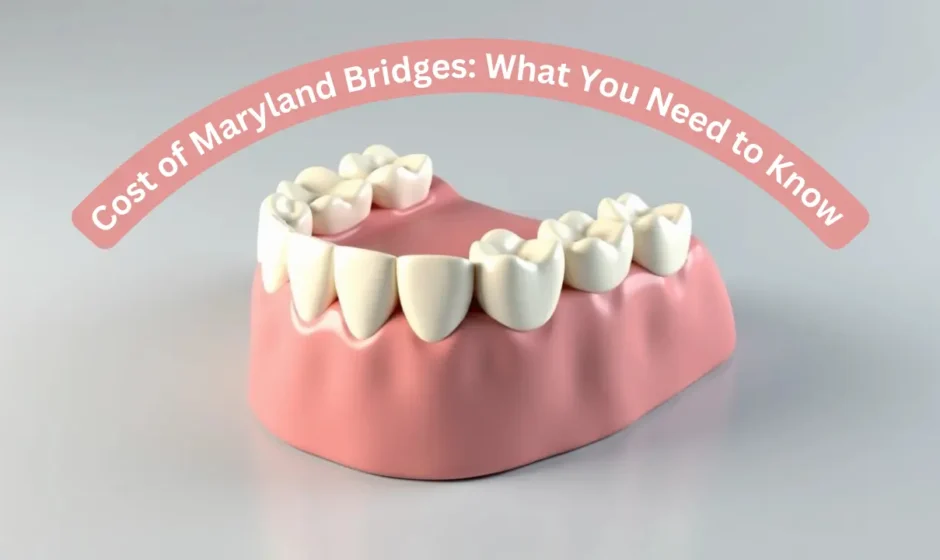Introduction
Cost is frequently a consideration when evaluating Maryland bridge as a way to replace a missing tooth. Maryland bridges on the whole tend to be more budget friendly than a number of oral dental implant solutions, however, there have to do with a few aspects when thinking about the last expense of the crowns. In this article, we will break down the cost of Maryland bridges, the factors that affect pricing and how to manage these costs.
How much does it cost to get a Maryland bridge put in place?
Typically the cost for a Maryland bridge varies from $1,000 – $2,500 per tooth. This price includes:
- Initial Consultation: Taking x‐rays of the missing tooth and its adjacent teeth.
- Materials Used: The pontic and wings were porcelain, metal or zirconia.
- Fabrication: The bridge is customizing in a dental lab.
- Placement Procedure: The adhesive bonding and final adjustment.
Cost Variations
- Porcelain or Zirconia Bridges: As a result, they are more expensive because of their aesthetic quality and because of sophisticated fabrication techniques.
- Metal Wings: Less costly generally but if visible may affect appearance.
What affects the price of a Maryland Bridge?
1. Situation of the Dental Practice (Crown land)
- Urban Areas: The cost of dental practices in metropolitan areas is usually high because of expenses related to the operational costs.
- Rural Areas: In more populated areas overhead may be lower, so you may get lower costs.
2. Dentist’s Expertise
- For example, dentists who have specialized training, or a large amount of experience in restorative dentistry, may charge more.
- While affiliated to general dentists may charge lower prices for the Maryland bridges, it is a gamble on how their expertise is.
3. Materials Used
- Porcelain and Zirconia: Because of its superior aesthetics and durability, the higher cost.
- Composite Resin: Less durable, but more budget friendly.
4. Complexity of the Case
- Number of Teeth Involved: As with most dental implant procedures, the higher the number of teeth replaced or supported, the more expensive the cost.
- Condition of Adjacent Teeth: In addition, expenses may increase where additional treatments are required e.g., fillings and gum therapy.
5. Laboratory Fees
- The cost is compounded by custom fabrication of the bridge in a dental lab.
- However, advanced technologies such as CAD/CAM (computer aided design and manufacturing) may lead to an increase of accuracy in orthoses at the cost of their prices.
Additional Costs to Consider
1. Diagnostic Procedures
- X-Rays or Scans: It is necessary to determine the health of your surrounding teeth and gums.
- Impressions or Digital Scans: Able to be used for accurate customization of the bridge.
2. Pre-Treatment Procedures
- Gum Treatments: Before placement, addressing one underlying gum disease.
- Teeth Cleaning: To ensure clean and plaque free bonding surfaces.
3. Follow-Up Visits
- Regular check ups to see the bridge is still protecting them.
- Some degree of adjustment or re-bonding if the adhesive deteriorates with time.
Cost Comparison: Providing Maryland Bridges vs Other Dental Options
| Option | Cost Range | Key Features |
| Maryland Bridge | $1,000–$2,500 | Affordable for single tooth replacement, minimally invasive. |
| Traditional Bridge | $2,000–$5,000 | Durable for more than one tooth, it requires tooth reshaping. |
| Implant-Supported Bridge | $3,000–$6,000+ | Surgical procedure required and is long lasting. |
| Removable Partial Denture | $500–$1,500 | They were budget friendly, less stable and aesthetic. |
Maryland Bridges Insurance Coverage
1. Does Maryland Bridge insurance cover Bridges in your mouth?
- Maryland bridges are generally covered at least in part under restorative procedures by most dental insurance plans.
- The amount of coverage depends on the policy and the provider and may be from 50% to 80%.
2. Factors Affecting Coverage
- Reason for Tooth Loss: If you lost your tooth due to an accident, coverage may vary; if the tooth loss is due to a pre-existing condition, the plan covers it.
- Annual Maximum: Maximum benefits are often limited annually between $1,000 and $2,000.
3. Preauthorization
- However, some insurance companies demand that you get prior authorization for the treatment, where you must send them a treatment plan and diagnostic materials before they agree to pay for it.
Maryland Bridges’ Financing Options
1. Payment Plans
- In many dental practices, they are now options to pay for dental care in installments over time; a practice may offer in house financing.
2. Third-Party Financing
- Healthcare financing is not solely offered by your bank – there are companies like CareCredit that offer healthcare financing with low or no interest rate payment plans for qualified applicants.
3. When speaking of HSAs and FSAs, we might be talking about:
- These accounts allow patients to use pre-tax dollars to cover dental expenses, including Maryland bridges.
4. Dental Discount Plans
- Refers to reduced fees for services from participating providers and are not insurance.
Tips for Managing the Cost of a Maryland Bridge
1. Get Multiple Quotes
- By comparing estimates from one dental practice to another, you can better determine which provider is right in your budget.
2. Prioritize Materials
- However, if aesthetics aren’t a priority, you can use less expensive materials such as composite resin.
3. Ask About Discounts
- There are dentists who will give out a discount if you pay up front or if you don’t have insurance.
4. Check Insurance Benefits
- Maximize coverage and out of pocket costs with review of your dental insurance policy.
Is a Maryland Bridge Worth the Cost?
Advantages
- And much cheaper than more invasive methods such as implants.
- It’s a quick process for placement, so it cuts down on the dentist chair time.
- Aesthetics and function are restored with minimal disruption of adjacent teeth.
Considerations
- This option is less durable than traditional or implant supported bridges leading to additional cost for repairs or replacement.
- But not for all cases, for example if molar replacement or heavy chewing is required.
Real-Life Scenarios: Cost Breakdown
Scenario 1: What is Single Front Tooth Replacement?
- Initial Consultation: $150
- X-Rays: $100
- Maryland Bridge Fabrication: $1,200
- Total: Partial insurance coverage of 50% is $1,450, out of pocket cost is $725.
Scenario 2: Replacements of Front Teeth
- Initial Consultation: $200
- Gum Therapy: $300
- Two Maryland Bridges: $4,000
- Total: It costs $4,500, with co pay at 50%, and $2,250 out of pocket.
Conclusion
How much will a Maryland bridge cost depends on where in Maryland, what materials are used, and how complex the case is. It’s a cost effective, minimally invasive solution for replacing a missing tooth, but understanding the costs and looking at financing will help you afford it. Your Maryland bridge should fit your dental needs and budget so, by talking with your dentist and checking your insurance benefits, you can make sure this is the case.



